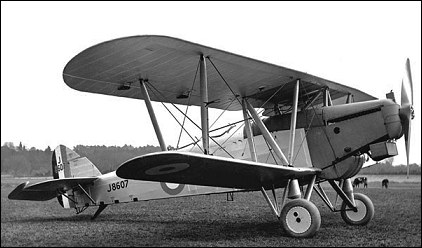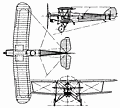 |
Hawker Horsley1925 |  |
| BOMBER | Virtual Aircraft Museum / United Kingdom / Hawker |
 |
The Horsley was produced for the RAF as a bomber and torpedo bomber, entering service in these roles in 1927 and 1928 respectively after severe competitive tests against the Westland Yeovil, Bristol Berkeley and Handley Page Handcross. The Greek Naval Air Service also received six in 1928, and it was licence-built in Denmark as the Dantorp (military designation H.M.III). In total 121 Horsleys were built, most powered by 499kW Rolls-Royce Condor IIIA geared engines and with all-metal airframes, although early production aircraft were of wooden and then mixed construction. In its class, it had an excellent performance. Apart from its speed and climb, it possessed the manoeuvrability of a scout and the aerodynamic design was such that the machine could be flown 'hands off' for periods of more than i^ive minutes. The range, of course, varied according to the mixed load of bombs and fuel, and day or night operations were possible. The excellent range and load-carrying ability of the Horsley made it suitable for very-long-distance flying: a special Horsley was produced with extra fuel tanks with a view to carrying out RAF training for duration and non-stop long-distance work. In fact the Horsley made three long-distance flights. The first was carried out by Flt Lt Carr as pilot and Flt Lt Gillman as navigator, who had expected to cover more than 6,440km from Cranwell to India. However during 20-21 May 1927 they covered a distance of 5,502km, landing short near Bandar Abbas on the Persian Gulf because of problems with the oil system. A second effort by Carr and Flt Lt Mackworth ended after one hour's flying; while a third attempt by Carr and Fl Officer Dearth ended in Austria, alighting in the River Danube. For the attempts 5,000 litres of fuel were carried in seven tanks and it is a remarkable fact that, with an overload of nearly 200% of the structure weight, the Horsley could land safely.
Peter Theobald, e-mail, 09.01.2021  John Smith John SmithThe Horsley name was chosen as a tribute to T.O.M. Sopwith, his home was Horsley Towers, the Horsley was named after that.
|  COMPANY PROFILE | |||||||||||||||||||||||||||||||||||||||||||||||||||||||
 |

|


Hi Duncan,
There were two Horsleys configured for the distance record, the first was J8607. That took off from Cranwell, piloted by Flt Lieutenants Carr and Gillman. This machine briefly held the long distance record, having ditched in the Persian Gulf en-route to India. Some sources say that it ran out of fuel but others say that it was brought down by an oil system problem. Carr and Gillman spent a night afloat on their upturned machine before being rescued.
The next Horsley, J8608, again captained by Flt Lt. Carr but this time with Flt Lt. Dearth as 2nd pilot /navigator, was to make two attempts at the record. The first ended after a mere hour aloft when an oil leak was spotted and Carr safely landed the heavily overloaded aircraft at RAF Martlesham Heath in Suffolk. The next attempt ended in failure at Aschach, Upper Austria, again following power plant issues. As the country was mountainous, Carr elected to put the aircraft down on the Danube. He escaped with minor injuries but Dearth was less fortunate, breaking several ribs and suffering from suspected internal bleeding. Both crewmen were lucky as they were quickly assisted by locals after the ditching. The engine was removed from J8608 and returned to the U.K. for analyses but no further record attempts were made using the Hawker Horsley.
reply